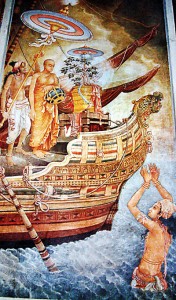Sanghamitta Theri’s thousand-year mission in Sri Lanka
The sudden appearance of thousands of shaven-headed, saffron-robed bhikkunis, following the establishment of the Bhikkhuni Order by Sanghamitta Theri, may have made quite an impact on society in the ancient capital- Anuradhapura. According to ancient chronicles, inscriptions and literature, the impact in fact had lasted in the island for well over a thousand years.
Sanghamitta Theri arrived in Sri Lanka on an Uduwap Poya day in 236 BCE when 20,000 samaneris led by Queen Anula, the sister-in-law of King Devanampiyatissa (BCE 250-210) were ordained. Dipavamsa says that about 16,000 bhikkhunis accompanied SanghamittaTheri to Sri Lanka.
The immediate concern therefore for the ruler – King Devanampiyatissa was to provide accommodation for this large number of bhikkhunis – a need that paved the way for nunneries to emerge which were suitable to reside and in an environment conducive to pursue Buddhist Teachings.
According to the publication – “Parani Lankan Bhikshu Bhikshuni Arama” (Ancient Lankan Nunneries of Bhikkhus and Bhikkhunis) written by State Literary Award winner, Colombo University Emeritus Professor Indrani Munasinghe, Queen Anula and the samaneris, having listened to the discourses of Mahinda Thera, were spending time observing the ten precepts of the Buddha’s Teachings. While awaiting the arrival of SanghamittaTheri to receive ordination, a house had been arranged for them to reside which belonged to a Minister called “Dhola”. Since the samaneris were addressed as upasikas at the time, the nunnery where they lived earned the name “Upasika Viharaya.”
King Devanampiyatissa who was keen to provide suitable accommodation for Sanghamitta Theri and the accompanying bhikkhunis, demarcated the Upasika Vihara, strengthened its outer boundaries and built three great mansions within its premises. Nine more mansions were added to accommodate all the bhikkhunis and the “Upasika Viharaya” with 12 mansions thereafter was offered to Sanghamitta Theri and the bhikkhunis for their residence and religious practices.
The nunnery gained further historical significance when King Devanampiyatissa converted the first three mansions to a museum – which turned out to be the first museum of Sri Lanka. As the monarch respected every aspect of Sanghamitta’s monumental visit, he held the ship in which was brought the Sapling of the Bodhiya from India in high esteem and thus placed for posterity the vital parts of the boat – the mast, the wheel and the oars in the three mansions he built.
The King was closely watching the interests of SanghamittaTheri when he found that she was spending more time at the Thuparama Shrine, indulging in contemplation and meditation in solitude. The site of Thuparama used to be the haunt of the royal elephant which the King selected as the site for the Sthupa on the advice of Mahinda Thera.The King proceeded to build a nunnery for Sanghamitta Theri on the premises of Thuparama with halls, individual chambers and flowering plants encircling the nunnery creating an environment conducive for religious pursuits. As this had been the location of the abode of the royal elephant, the nunnery thus built and offered to Sanghamitta Theri was named Hatthalhaka nunnery.
Professor Munasinghe writes that sections of Hatthalhaka nunnery were dismantled later to make way for the construction of the city wall of Anuradhapura and to demarcate the river Kolom. This was the time of South Indian invasions which may have prompted Kutakannatissa (BCE 44-22) to build a wall round Anuradhapura city encircling it with a moat. Later, King Vasabha had increased further the height of the wall.
Among the bhikkhunis who were ordained in the early years were queens, princesses and women from the upper classes whoinvolved themselves in religious and educational activities. Anuradhapura was the hub of religious activities with programmes being conducted by the Maha Vihara, Abhayagiri and Jetawana Vihara. The earliest nunneries thus were located in the city. Besides, unlike for bhikkhus, reasons of safety also figured in the selection of the location.
A fact mentioned in the Mahavamsa that “Maathu Vihara” – a nunnery was built by Saddhatissa in Anuradhapura indicates that Vihara Maha Devi had been ordained as a bhikkhuni. The Mahavamsa also mentions King Kutakannatissa as having built the Danthagehe nunnery for his mother within the Royal Palace.
Prof. Munasinghe reveals that the watering ritual of the Sri Maha Bodhiya was an exclusive function of the royal women. Four Queens had been sent by Emperor Asoka to perform this sacred ritual. Later, the task had been carried out by royal maidens. By the 9th century, this function, according to documentary evidence, had been taken over by bhikkhunis.
The numbers of bhikkhunis in the meantime, had rapidly grown. Mahavamsa reveals that 94,000 bhikkhunis participated in the mammoth almsgiving offered at Mirisavetiya Sthupa by King Dutugamunu (BCE 161-137.) The gifting of robes by Mahachulatissa (BCE 77-63) to 60,000 bhikkhus and 30,000 bhikkhunis gives further evidence of enhanced numbers of bhikkhunis and their participation in state events.
Developments that took place in the religious landscape did affect the Bhikkhuni Order as the impact of clashes between Mahavihara, Abhayagiri and Jetawana Vihara led some bhikkhunis to turn nonconformists. King Mahasena (CE 274-301) who turned againt Maha Vihara and gave patronage to Abhayagiri Vihara built two nunneries -Uttara and Abhaya for bhikkhunis of the Abhayagiri sect. According to an inscription of Mihindu the 4th Pankuliya Vihara belonging to Pabbatharaama of Abhayagiri Vihara complex was built exclusively for bhikkhunis. Further, the nunnery “Rajina” built by King Mugalan the first for denaanaka or Sagalika bhikkhuni of Jetawana sect, gives evidence of the existence even of the extremist Sagalika sect in Sri Lanka.
Evidence reveal that the numbers of bhikkhunis swelled in the 7th, 8th and the 9th centuries as the largest number of nunneries had been built during this period. The Bhikkuni Order had lasted right to the end of the tenth century as the final mention of a nunnery in the Chronicles had been made during the reign of Mihindu the 4th (CE 956-972.) It is said that he built the Mahamallaka nunnery for Theravada bhikkhunis.
The Chola invasion at the end of the Anuradhapura period caused the complete disappearance of the Bhikkhuni Order. However, Prof. Munasinghe remarks that Vijayabahu the first (CE 1055-1110) brought down bhikkhus from Burma to revive the Bhikkhu Order which also disappeared from Sri Lanka as a result of the Chola invasions. Quoting Prof. Ranaweera Gunawardene, Prof. Munasinghe says that according to Burmese inscriptions, Theravada bhikkhunis had existed in Burma in 1196 and even in 1279, nunneries had existed for Burmese bhikkhunis. King Vijayabahu’s failure to revive the Bhikkhuni Order through Burmese bhikkhunis delayed the revival of the Bhikkhuni Order in Sri Lanka by over a thousand years.


